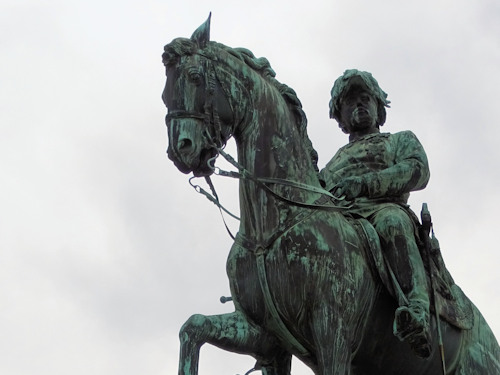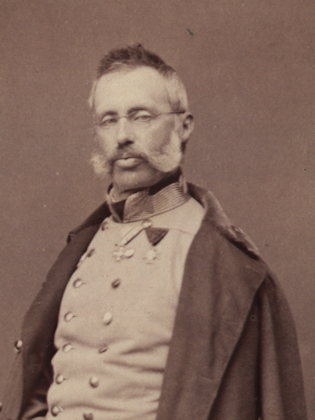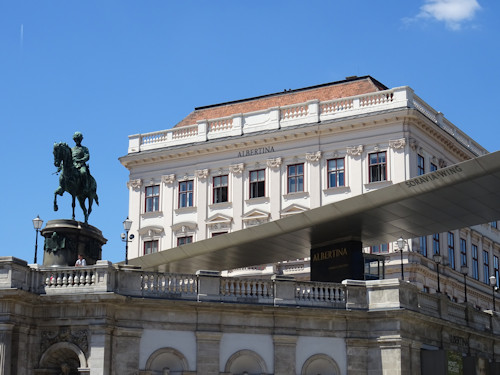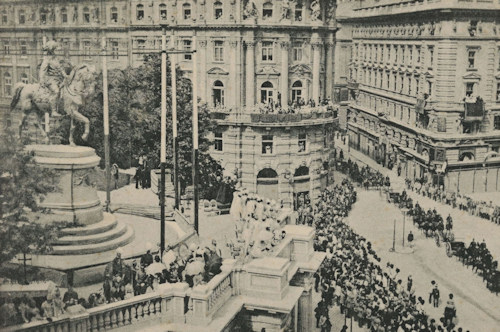
Should you emerge from the home of Picassos, Modiglianis and more, a sculpture of a rather different kind confronts you: the monument to Archduke Albrecht, the Duke of Teschen (not someone likely to have approved of modern art).
- Bronze equestrian statue unveiled in 1899
- Honours Albrecht as a 19th-century Habsburg military leader
- Located outside the Albertina art museum
- Book a guided tour* of the Hofburg area
- See also:
Soldier and palais owner

(The view from below)
Judging the life and works of various Habsburgs is often a tricky business when seen through a modern lens.
Take Archduke Albrecht (1817-1895), for example, grandson of Emperor Leopold II and nephew of Emperor Franz I/II.
Albrecht enjoyed some significant victories as a military commander, where he attained the rank of Field Marshall and ended his career as General Inspector of the entire imperial army. This alone lets him stand out from his Habsburg colleagues, most of whom had precious little military talent.
(Though Albrecht’s father famously beat Napoleon at the Battle of Aspern in 1809, earning himself his own equestrian statue, too.)

(Albrecht sporting a fine bit of facial hair in an 1866 photo by the studio run by Adele Perlmutter; Wien Museum Inv.-Nr. 103431/581; excerpt reproduced with permission under the terms of the CC0 licence)
This service and prowess on the field of battle earned the Archduke various memorials, including the 10m-high bronze equestrian monument that sits on the small square in front of the Albertina palais that he once owned.
Historians, however, suggest Albrecht’s conservatism and intolerance of progressive perspectives likely hindered the modernisation of the Austro-Hungarian military as the 20th century approached.
And we all know what happened soon after the 1900s began.

(The location gives Albrecht a good view across to the opera house)
Donations from within the military financed the initiative to build the Albertina monument, led by a committee formed around Archduke Friedrich (Albrecht’s nephew and the then occupant of the palais).
The sculptor Caspar Zumbusch designed the 7,000 kg statue, thus completing a quartet of famous monuments from the same hand (others are for Beethoven, Radetzky, and Maria Theresa).
Although Zumbusch drew on photographs for his work, he would have known the Archduke quite well by sight: Albrecht apparently visited the sculptor as he worked on the Radetzky monument.
According to a newspaper report of the time, it took four months to produce the original designs and a year to create the actual model for the casting process.

(The celebrations around the unveiling of the monument on May 21st, 1899, as photographed by Charles Scolik and produced by A. Sockl; Wien Museum Inv.-Nr. 65861/128; excerpt reproduced with permission under the terms of the CC0 licence)
The architect Karl König designed the granite pedestal with its bronze reliefs and inscriptions. I translate the latter as:
- Field Marshall Archduke Albrecht of Austria 1817 – 1895
- In grateful remembrance of the victorious commander and fatherly leader
- To the Commander-in-Chief His Majesty the King and Emperor Franz Joseph December 2nd 1898 Austria-Hungary’s Military
The date of the dedication seems confusing given the actual unveiling took place on May 21st, 1899. December 2nd, 1898 would have honoured the 50th anniversary of Franz Joseph’s accession, but they seemingly postponed celebrations after the assassination of Empress Elisabeth.
The new date coincided with the 90th anniversary of the Aspern victory over Napoleon, and Franz Joseph himself unveiled the monument in front of almost the entire upper echelon of the military: a 72-gun salute followed.
How to get to Albrecht
Find your way to the Albertina museum and Albrecht sits just outside on the raised platform above the wall fountain that also bears his name. You can take excellent photos from here of the Staatsoper (especially at night).
Incidentally, movie buffs might recognise the Albrecht monument as a location in Before Sunrise: Jesse recites Auden’s poem to Céline on the monument’s steps.
The very same steps also appear (possibly as a homage to Before Sunrise) in Sachertorte: another Vienna-based romantic movie.
Address: Albertinaplatz, 1010 Vienna